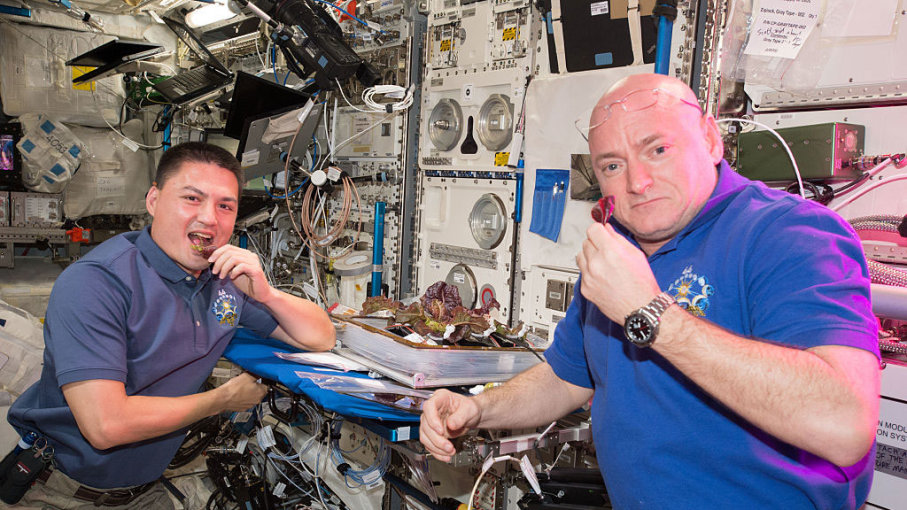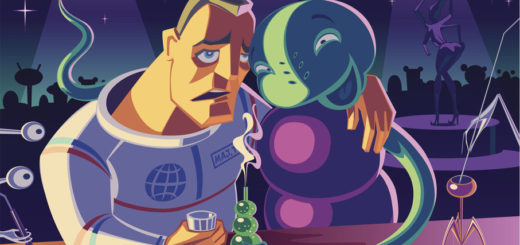Scientists Working on Converting Human Waste Into Food for Astronauts

NASA astronauts Scott Kelly (R) and Kjell Lindgren get ready to eat the first food grown and harvested in space on the International Space Station on Aug. 10, 2015. What they’re eating was not made from human waste, but that could change in the future. NASA VIA GETTY IMAGES
A manned mission to Mars might take around six months. Suffice it to say, when mealtime rolls around, astronauts won’t be dial up delivery pizza en route. Instead, they may be eating nutrition derived from their own fecal matter, a concept that would save on cargo space and weight while maximizing materials already found on the spacecraft.
At Penn State University, scientists are developing a system that leverages certain types of microbes that convert human solid waste into protein- and fat-laden foods. Researchers, for better or worse, have already called the result a “microbial goo” that’s sort of reminiscent of Vegemite, a comparison that seems unlikely to please the food product’s corporate executives.
Because it’s difficult and time-consuming to grow food in space, astronauts have to rely on items in their closed environment. The linchpin of the system is anaerobic digestion, which can break down certain materials without the need for oxygen. It’s a common process for reducing municipal waste on Earth.
In tests, the digestion process produced methane gas. That gas turns out to be useful in growing a microbe called Methylococcus capsulatus, which is already used for animal feed pellets, that’s about 52 percent protein and 36 percent fat content. According to the National Academy of Sciences, humans function best when they ingest nutrition with about 50 percent carbohydrates, 20-35 percent fat and 10-35 percent protein, so the goo still has a ways to go before it’s an ideal food source.
The tests relied on substitute liquid and solid waste instead of actual human wastes. When the real thing is introduced, there will also be concerns about pathogens that could cause illnesses. That’s where tweaking the pH levels or temperatures may help.
Tests showed that by increasing the system’s temperatures to around 158 degrees F (70 degrees C), most germs were eliminated, yet the nutritious microbe Thermus aquaticus survived. Alternately, they raised the alkalinity of another batch and found that bacteria called Halomonas desiderata still managed to proliferate, while germs did not.
The team borrowed concepts from commercial aquarium filters that use fixed-film filters to neutralize fish waste. The filters incorporate a bacteria-laden film and are adapted by researchers to accommodate methane production. The result? Solid waste can be treated in a matter of hours instead of days. Plus, because the system is self-contained, it doesn’t really require much babysitting, other than, you know, the necessary inputs.
There’s also the matter of taste. Lisa Steinberg, the lead author on the study, says that the bacteria could be mixed with other materials and flavors to make it more palatable. “It’s nearly certain that there would be plants grown in conjunction with this food stuff, which would provide additional flavors and textures,” she emails.
What about the potential psychological issues associated with consuming a material of dreary origins? “Astronauts already have to drink their own processed urine,” says Steinberg. “So, they are probably accustomed to things being done differently in space than on Earth.”
In space, poop is often a problem. Maybe now poop will be part of the solution. While the still-experimental concept may not exactly fire up astronaut’s appetites, it may eventually provide sustenance to space explorers who have limited buffet options amongst the stars.



 Creators of mankind
Creators of mankind Description of “Tall white aliens”
Description of “Tall white aliens” Where they came from?
Where they came from? About hostile civilizations
About hostile civilizations The war for the Earth
The war for the Earth “Tall white aliens” about eternal life
“Tall white aliens” about eternal life Video: “Nordic aliens”
Video: “Nordic aliens” Aliens
Aliens Alien encounters
Alien encounters The aliens base
The aliens base UFO
UFO Technology UFO
Technology UFO Underground civilization
Underground civilization Ancient alien artifacts
Ancient alien artifacts Military and UFO
Military and UFO Mysteries and hypotheses
Mysteries and hypotheses Scientific facts
Scientific facts


















